Haskap Varieties
Haskap, also known as blue honeysuckle, is a an exciting new fruit crop in North America. It’s getting a lot of attention lately from farmers, food lovers, and even the media. The best kinds taste like a mix between blueberries and raspberries—super tasty! One of the benefits of haskaps is that they ripen really early, around mid-June, which means you get fresh fruit before almost anything else is ready. They can handle cold winters, are loaded with antioxidants and vitamins, and don’t need a lot of chemicals to grow, especially on the Prairies. In fact, they can often be grown organically. They have been bred to harvest mechanically, which makes life easier for farmers. There’s a lot of interest from Japan, and since they naturally grow well in colder climates, it’s harder for places with warmer weather to grow them. Food companies, especially those working with dairy products, are also really curious about using haskaps in things like yogurt and ice cream. The first variety in the series, Boreal Beauty, was released in early 2017. Boreal Beauty was chosen for its large size, firmness, and good flavor. The Boreal series also includes Boreal Blizzard and Boreal Beast, released in 2014 and 2016 respectively.
Boreal Series
The Boreal series of haskap varieties was created from a strategy to combine desirable attributes of germplasm from Russia, Japan and the Kuril islands. Selection for vigour and general health occurred in the greenhouse. Field evaluations 5 to 7 years later were made of thousands of seedlings of which 200 superior selections were analyzed for fruit qualities in the lab. Breeding with diverse genotypes resulted in many selections exceeding parental germplasm for various desirable characteristics. For example, average fruit weights of Boreal Blizzard and Boreal Beauty are greater than other cultivars and about twice as heavy as most cultivars. Boreal Blizzard has half the acidity of most Haskap varieties while Boreal Beast is the only cultivar that ripens in August in Saskatchewan. Boreal Beast was chosen as a pollinizer for the other two Boreal varieties as it had compatible pollen and bloom time largely overlapped. Its flavour ratings were among the highest over several years of evaluation. The strategy of intercrossing diverse germplasm is resulting in transgressive segregation from which breakthroughs in haskap breeding are occurring.
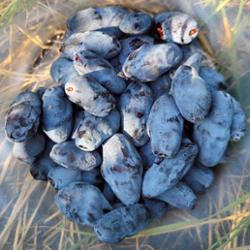
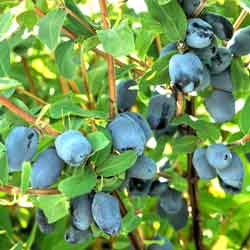
‘Boreal Beauty’ is an exciting haskap variety that opens up an entirely new season for Haskap growers: It had fruit fully ripe a month after most varieties finish! Its plant and berry characteristics fit all categories suitable for mechanical harvesting. Berries are heavy, firm, mostly oval, and hold onto branches with just the right amount of force and taste great. Bushes are strong and upright growers and show no signs of mildew and are very productive. Almost all large-fruited haskap cause branches to bend over, but not ‘Boreal Beauty’, her branches remain strong and upright. The occasional tip on some of the berries, which make many of the largest berries look like a heart, could be a disadvantage, but that could be a charming aspect too for fresh sales. Its berries are almost as heavy as ‘Boreal Blizzard’ berries although they are only 2/3rds as long and are considerably thicker.
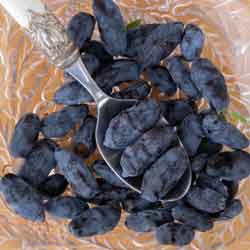
‘Boreal Beast’ was named to help people remember that ‘Beauty and the Beast’ belong together for cross pollination. ‘Boreal Beast’ starts shedding pollen when ‘Boreal Blizzard’ starts and ends when ‘Boreal Beauty’ ends and is pollen compatible with them and ‘Aurora’. The late bloom characteristic of ‘Boreal Beauty’ is very rare. ‘Boreal Beast’ is the closest of our advanced selections for being in sync with ‘Boreal Beauty’ for bloom time that also has qualities showing commercial potential. While ‘Boreal Beast’ isn’t as pretty as ‘Boreal Beauty’ it is remarkable for flavour when fresh or frozen. On average it has received a 4.5 rating on a 5 point scale being evaluated for 3 years in a row. (Very few selection get 4.5 or higher). Field notes indicates it has “one of the best aromas' and “very nice aftertaste”. Ripening in mid to late July, harvest can occur after ‘Aurora’ and ‘Boreal Blizzard’but before ‘Boreal Beauty’ With a berry size of 2 grams, its berries can hold onto bushes for a longer time than varieties with even larger fruit. More research is needed but it is thought that ‘Boreal Beast’s berries might hold on long enough to be harvested at the same time as ‘Boreal Beauty’ and perhaps could be planted in the same row. (Planting in the same row may increase cross pollination activities of honey bees which tend to stay in the same row.)
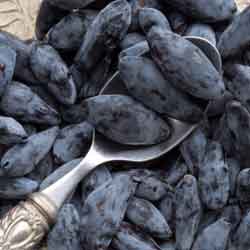
‘Boreal Blizzard’ was so named because the fruit size, productivity, and flavour stopped us in
our tracks. Like a major winter storm, ‘Boreal Blizzard’ was hard to forget when evaluating other lines in our breeding fields. ‘Boreal Blizzard’s berries are more than twice as heavy as ‘Tundra’ or ‘Borealis’ and are three times heavier than the largest varieties in the ten years of research trials. The berry of ‘Boreal Blizzard’ is very meaty and heavy, and containing almost no air pockets which can affect berry weight.
Tundra
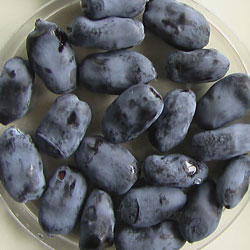
‘Tundra’ is best suited for commercial production. It's fruits are firm and can withstand commercial harvesting and sorting. Firmness is a rather rare trait especially for large fruited blue honeysuckles (Haskap). Ranking at almost the top for flavour and fruit size the shape of its fruit was deemed acceptable for the Japanese market. Its firmness and the fact that this variety does not ‘bleed’ from the stem end when picked could make this variety especially suited for Individually Quick Frozen (IQF) processing.
Indigo Series
The Indigo series varieties are sisters to 'Borealis' (breeding ID '9-94') and 'Tundra' (breeding ID '9-84'). The 'Indigos' were originaly released as test varieties the breeding IDs of 9-15, 9-91 and 9-92. All of these varieties are closely related and have the same mother and father. The 'Indigos' were considerd 'runner-ups' to 'Borealis' and 'Tundra'. These varieties are occasionally referred to as 'Row 9' which is the seedling row that they grew up in.
There has been some concern about whether to call this series 'Haskap'. In 2009, Haskap Canada attempted to tradmark the term 'Haskap' but was turned down by the Canadian government. The term 'Haskap' was deemed a term for generic crop in use internationally and could not be trademarked.
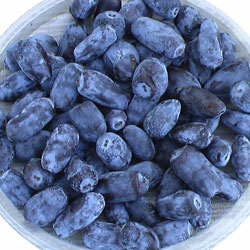
The original bush was the most productive of “Row 9”, but the berries were the smallest, and showed slight susceptibility to mildew. The fruit had a slight ‘chewiness’ that perhaps could indicate a more durable fruit and potentially better for processing. This variety has shown to have more upright growth and may grow faster.
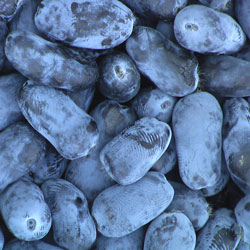
This variety is most similar to Tundra with the berries being about 10% smaller. Easier to propagate than tundra. The berries are slightly more elongated than other varieties and it has excellent flavour.
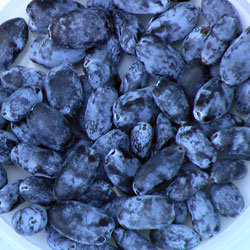
The berries are slighty more elongated than other Haskap varieties. The variety is difficult to propagate making it undesirable in the market.
Honey Bee
The ‘Honey Bee’ variety was selected to be a pollinator for ‘Borealis’, ‘Tundra’ and the ‘Indigo’series (BTI). It blooms at the same time and has given good fruit set when used in controlled crosses with them. It is very fast growing, productive and starts fruiting at an early age.
Its fruits are cylindrical and look more like its Russian paren, similar to the shape of a bee’s body. Unlike most Russian varieties used for pollination, ‘Honey Bee’ holds onto its fruit firmly and stays on the bush longer than most other varieties. Unilike most most Russian blue honeysuckles varieties drop their fruit as soon as ripe in late June or early July, but not ‘HoneyBee’ was observed to hold onto its fruit firmly until the 3rd week of August. The stems stay on the fruit about 40% of the time when picked. That cylindrical shape doesn’t roll around very well in equipment, so this variety is definitely not recommended for m mechanical harvesting, unless juice is the goal.
Borealis
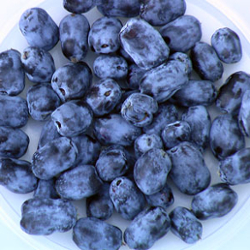
‘Borealis’ has great flavour and a very large fruit size with its fruits measuring almost twice the size of the 35 Russian varieties in our USask collection. The downfall of the variety is this variety does not have the firmness of ‘Tundra’ and it is not suitable for mechanical harvesting as it tends to get a bit mushy when handled with equipment. The variety is best for home gardeners or U-pick operations who can hand pick the delicate fruit. If one chooses to shake harvest the fruit, the berries will be damaged and will need to be quickly processed.
Aurora
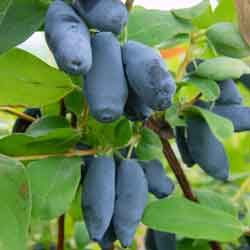
‘Aurora’ was released to propagators in 2012 and available to fruit growers and gardeners in 2014. It obtained Canadian plant breeders rights in 2018 (certificate 5750). It was selected as one of the best of the mid-season types from among 10,000 seedlings and a decade of breeding.
‘Aurora’ was originally selected to be a companion variety for ‘Borealis’ ‘Tundra’, and ‘Indigo’ (BTI) series Haskap. ‘Aurora’ gave excellent set when hand crossed to the BTI varieties and was observed to bloom in sync with them. It was also found to be compatible with ‘Honey Bee’. The first growers of ‘Aurora’ often planted them in low numbers to serve as a pollinator for ‘Tundra’ or ‘Indigo Gem’. As growers became familiar with ‘Aurora’ it became clear that ‘Aurora’ was the superior variety. Growers began planting fields of mostly ‘Aurora’ plants and ‘Tundra’or ‘Indigo Gem’ being used as the pollinator. Observation trials at the University of Saskatchewan indicate that ‘Aurora’ and ‘Honey Bee’ are the most productive of the early blooming and ripening varieties and those two varieties should be planted together for cross-pollination.

